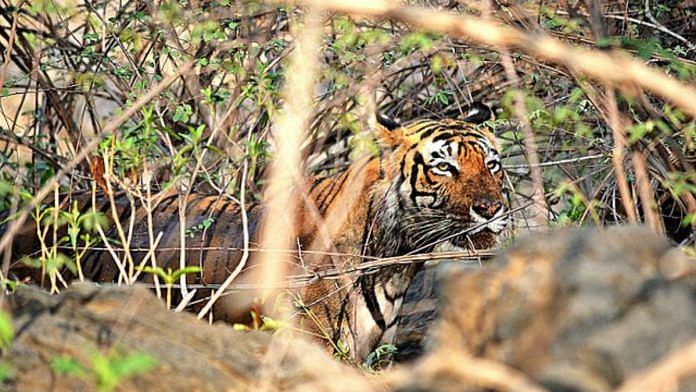New Delhi: Among the Central Empowered Committee’s (CEC) recommendations for reducing stress levels and improving breeding among tigers in the Sariska Tiger Reserve in Rajasthan, the one likely to have an immediate visible impact is a blanket ban on private vehicle movement to the Pandupol Hanuman temple located in the reserve , experts say.
In its 22 July report, the Supreme Court-mandated CEC noted that high traffic movement, primarily of pilgrims commuting to the temple in the core area of the reserve, is severely impacting tiger breeding.
The committee suggested that instead of allowing unchecked movement of private vehicles, the authorities could consider alternatives, including the construction of electric tramways, ropeways, or an elevated or motorable twin tunnel to continue the pilgrimage while avoiding impact on wildlife.
Impact of uncontrolled human movement
Experts have warned that the increased human movement in protected forest areas, such as Sariska, can cause irreversible damage to its inhabitants.
Baiju Raj, director (conservation projects) at Wildlife SOS, a non-profit organisation, said that wild animals are extremely sensitive to light and sounds, and such regular and uncontrolled movement in their natural habitats can impact their breeding, foraging and nesting patterns.
“Animals, unlike humans, can hear even the minutest of vibrations. We have seen that in Sariska. The vehicular movements of pilgrims are not one or two, but hundreds of private cars move around. Such large movement also poses problems of vehicular emissions and waste generation, which itself could be harmful to the health of the animals,” Raj said.
A 2019 study by researchers from the Council for Scientific and Industrial Research—Centre for Cellular and Molecular Biology (CSIR-CCMB) also established the extreme stress that anthropogenic activities in wildlife reserves can have on the big cats.
The study examined the physiological stress response of tigers due to anthropogenic activities, including wildlife tourism in Bandhavgarh Tiger Reserve and Kanha Tiger Reserve, using faecal glucocorticoid metabolite (fGCM) measurement — the quality of faecal matter of animals, which gives a picture of their health.
The findings showed that fGCM concentrations were significantly higher in tigers during the tourism period, compared to the non-tourism period.
“The number of tourist vehicles and disturbance level significantly correlated with fGCM concentrations,” the study further noted.
Environmentalists and wildlife experts have also highlighted that CEC recommendations of ropeways and trams could be a good alternative for the reserve. These could eventually also be replicated in other sanctuaries, they said.
Also Read: Environment funds collected by pollution board in past 5 yrs largely unused, reveals govt response
Court intervention
The issue of unchecked vehicular movement in the reserve was brought to the notice of the Supreme Court in July last year by advocate K. Parmeshwar, who suggested the operation of radio-tagged electric buses in the reserve to ensure that the forest department could keep track of human activity in the area while keeping a check on incidents of poaching.
The apex court constituted a five-member expert committee to recommend interventions to check the movement of private vehicles. However, the committee’s report was found “incomplete” by the court, which then directed the CEC to assist the panel and submit a comprehensive report on the matter.
In May this year, the court had also expressed its concerns about the improper disposal of waste and plastic pollution, along with the problem of vehicular movement.
“If private vehicles are allowed to enter the area, they will keep honking and throwing waste in the forest,” a bench headed by Justice B.R. Gavai had said.
(Edited by Mannat Chugh)






